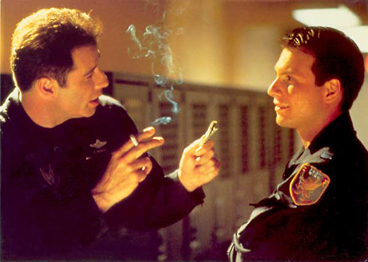A recent lapse in Air Force nuclear security brought some peculiar terms into the public consciousness. When six nuclear-tipped AGM-129 cruise missiles were accidentally loaded aboard a B-52H and flown across the country last summer, what USAF had on its hands was a “bent spear.”
This was very bad, but it wasn’t the worst thing that could happen. You would rather have to grapple with a bent spear than a “broken arrow” or a “faded giant.” And certainly nobody ever wants to have anything to do with an “empty quiver.”
 |
John Travolta (l) and Christian Slater (r) in “Broken Arrow.” |
What do these terms mean? They designate categories of nuclear-weapon incidents, accidents, and even disasters. They are all itemized in DOD Directive 5230.16, “Nuclear Accident and Incident Public Affairs Guidance.”
A bent spear, in Pentagon parlance, identifies a “significant incident” involving a nuclear weapon, warhead, or component, or a vehicle loaded with nuclear materials. A prime example of such an event was that mistaken B-52 transport of the six nukes from Minot AFB, N.D., to Barksdale AFB, La., where they sat undetected on the ramp for nine hours.
Even worse is a broken arrow, an actual accident involving a nuclear weapon, warhead, or component. It comprises unauthorized launch, nuclear detonation, or jettisoning of a nuclear weapon. There have been quite a few broken arrows over the years, often involving the crash of an aircraft carrying nuclear components. Some of these events are infamous:
- On Feb. 5, 1958, a B-47 carrying a nuclear weapon (but not the weapon’s trigger—its nuclear capsule, or “pit”) collided with an F-86 near Savannah, Ga. The damaged B-47 was unable to land with the weapon aboard. “The decision was made to jettison the weapon,” states a recap in “Department of Defense Narrative Summaries of Accidents Involving US Nuclear Weapons 1950-1980.” The weapon was dumped into Wassaw Sound and the crew landed safely. Without a nuclear capsule, it could not possibly have exploded. The bomb remains somewhere just under the sea bed.
- On Jan. 13, 1964, a B-52D encountered violent turbulence in a blizzard while ferrying two nuclear bombs. Part of the tail broke off, and the jet aircraft crashed in a mountainous area near Cumberland, Md. Only two of the five crew members survived. The nukes, covered by 14 inches of snow, were recovered.
- On Jan. 17, 1966, a B-52 bomber flying near Palomares, Spain, collided with a KC-135. Both aircraft crashed, seven airmen died, and four nukes were scattered. High-explosive materials in two bombs exploded on impact, releasing radioactive materials. Some 2.8 million pounds of “slightly contaminated soil and vegetation” were scraped up and sent to the US. Searchers recovered one intact bomb on land, the other, after a three-month search, in the Mediterranean Sea.
A faded giant is DOD’s term for either an accident affecting a nuclear reactor or some other type of radiological accident. Such events are rare. The most recent known example was the disaster aboard the Russian attack submarine Kursk, which in 2000 sank to the bottom of the frigid Barents Sea with all hands and with a pair of nuclear reactors.
Of all the nuclear scenarios, the most worrisome is the empty quiver—that is, seizure or theft of a functioning nuclear weapon. Hollywood offered its take on this nightmare in a 1996 thriller featuring John Travolta and Christian Slater, who played rival USAF officers battling over two stolen nukes. The movie was titled “Broken Arrow,” presumably because “Empty Quiver” just didn’t have much sex appeal.
The empty-quiver specter haunts US officials. “It is very clear that the al Qaedas of the world are interested in, and would be willing to use, nuclear terrorism,” said Linton F. Brooks, a former head of the National Nuclear Security Administration. Even so, Brooks said, “they are not willing to die gratuitously for a failure.” In other words, the US needs good nuclear security, and, more important, it must be seen to have good security.
In the period 1950-80, most bent spears and broken arrows took place during tactical ferry flights or in Strategic Air Command’s “Chrome Dome” airborne alerts. Flight safety has improved enormously, and these events have become relatively rare.
US policy forbids discussion of nukes at any location. The Air Force made a one-time exception a few months ago so that it could present initial findings of its probe into the Minot-Barksdale fiasco. Lt. Gen. Richard Y. Newton III, who presented the findings, called the event “an unacceptable error” stemming from complacency and an “unprecedented stream of procedural failures.” The Air Force’s initial probe revalidated security procedures, but it found airmen had become complacent and lackadaisical.
Given the hysteria that sometimes attends the whole subject of nuclear arms, it should be noted that there has never been “even a partial inadvertent US nuclear detonation,” according to DOD, “despite the very severe stresses imposed upon the weapons involved in these accidents.” That may be the result of procedures, designs, or luck. Probably it is some of everything. Whatever the reason, may it continue.